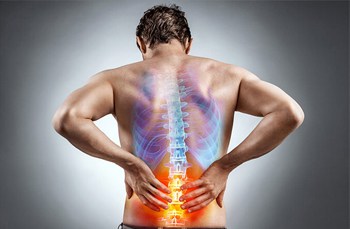Lumbar Stenosis
The lumbar spine is formed by five lumbar vertebrae. The anterior part of the vertebrae or vertebral body is joined to each of the following ones by the intercalation of a fibrous structure called the intervertebral disc. The posterior part of the vertebrae forms a bony arch. The sum of all the superimposed arches constitutes the lumbar canal. This arrangement occurs analogously in the cervical spine and in the thoracic or dorsal spine.
Lumbar stenosis is a pathological condition due to narrowing of the lumbar canal, which can cause compression of the neural structures that are housed within it, either the dural sac with the spinal nerves, or the spinal nerves themselves that emerge through the foramina.
Compression of the nerves can cause low back, buttock and leg pain, lameness, pain and decreased sensation in the legs. A common symptom is improvement of pain when leaning forward, or aggravation of pain when the trunk is brought backward. Patients with lumbar stenosis usually walk somewhat bent over to avoid pain, have to stop frequently to sit down, and walk better uphill than downhill.
There are several forms of lumbar stenosis:
- The most common is degenerative lumbar stenosis, which occurs with advancing age. The exaggerated growth of the bones, ligaments and joint deformity can produce generalized stenosis (at various levels of the spine) or segmental stenosis (at a single vertebral level). The narrowing conditions a compromise of space for the nerves and a series of symptoms are produced, such as lumbar pain and in the buttocks, neurogenic claudication and pain radiating to the extremities. Neurogenic claudication is the inability to walk for a prolonged period of time due to pain, requiring sitting to relieve it.
- Congenital lumbar stenosis is less common, and can occur at any age, often between 30 and 40 years of age. It is due to a congenital narrowing of the lumbar canal. The causes are not very clear but it is possibly due to developmental disorders in early childhood.
- Stenosis secondary to a displacement of a vertebra forward or backward. It is called spondylolisthesis, and depending on the degree of displacement, there may be more or less narrowing in the affected vertebral segment.
Lumbar stenosis that produces symptoms requires treatment, which will initially be pharmacological and rehabilitative. If the problem cannot be alleviated, invasive techniques such as epidural corticosteroid infiltrations will be necessary. Surgery is the last resort, and there are different surgical techniques that can solve the narrowing. The surgeon is responsible for choosing the best technique for each individual case.
Treatment of Lumbar Stenosis

CONTACT
If you wish to contact us, to make an appointment or request more information about our services, please do so here
Patient Reviews
After months of intense pain in my back and leg due to a hernia, and after being full of medications and rehabilitation sessions, finally a friend recommended this clinic and I was absolutely right. They visited me very quickly and Dr Ruiz performed a radiofrequency intervention that has solved the problem, it no longer hurts and I have regained my quality of life, which I had lost. I only have words of gratitude
I had a rhizolysis two years ago and it is the best decision I ever made. I was advised to go to this clinic. Excellent staff and treatment. I would come back without hesitation. I am a different person since I don’t feel any pain.
In a frankly desperate situation with my mother suffering from trigeminal neuralgia and with continuous and terrible pain during confinement and no public health doctor able to relieve her pain in any way, it was miraculous to find this center by surfing the internet. In just a couple of weeks after the initial visit, Dr. Ruiz operated on my mother in an outpatient and non-aggressive surgery and in just a few days she regained speech, mobility and finally began to sleep as she no longer suffered the tremendous pain. And if the treatment has been effective thanks to the hands of a great doctor, this does not mean that the whole team at the center is not deserving of credit. From the reception to the nurses, they are all exemplary professionals who make you feel safe and in good hands at all times. My mother is already another and just 4 months later we are aware that there is no better investment than health and Clínica Vértebra is a success. Totally recommendable. THANKS A MILLION.
It has been a long time since I felt what it was like to live without pain. I only have words of gratitude for the whole team, from the reception staff to the operating room team. Thank you Dr. Squarcia for such a detailed explanation of my problem and for the accuracy of the treatment. I pray to God that this wellness lasts for a long time.
I had a lumbar facet denervation (Rhizolysis) this morning and I have to say that «O» pain. It has been 10 hours since the intervention and I am still without any pain and without medication. Congratulations to the whole team. Viggo Adeler (Physician)
Good treatment and attention, I went with a horse sciatica and they left me like new, I only have words of thanks.
It is a place that has improved my quality of life.
I only have words of thanks to Doctors Ricardo Ruiz and Dr. Matias, I have gone to them twice, and I only have words of thanks, they have solved my problem, first of Lumbar vertebrae and the second of a shoulder, and in both cases total success, I have not returned to have any kind of discomfort, I am totally grateful to them, they have changed my life. THANK YOU DOCTORS, you are fantastic.
First visit with Dr. Mattia Squarcia, finally a doctor who listens to me and looks at all my medical tests. I have already had a bad experience with another pain clinic where the doctor did not listen to me and did not even look at a single medical test.
I have only words of thanks, thank you Doctor Ricardo Ruiz.







